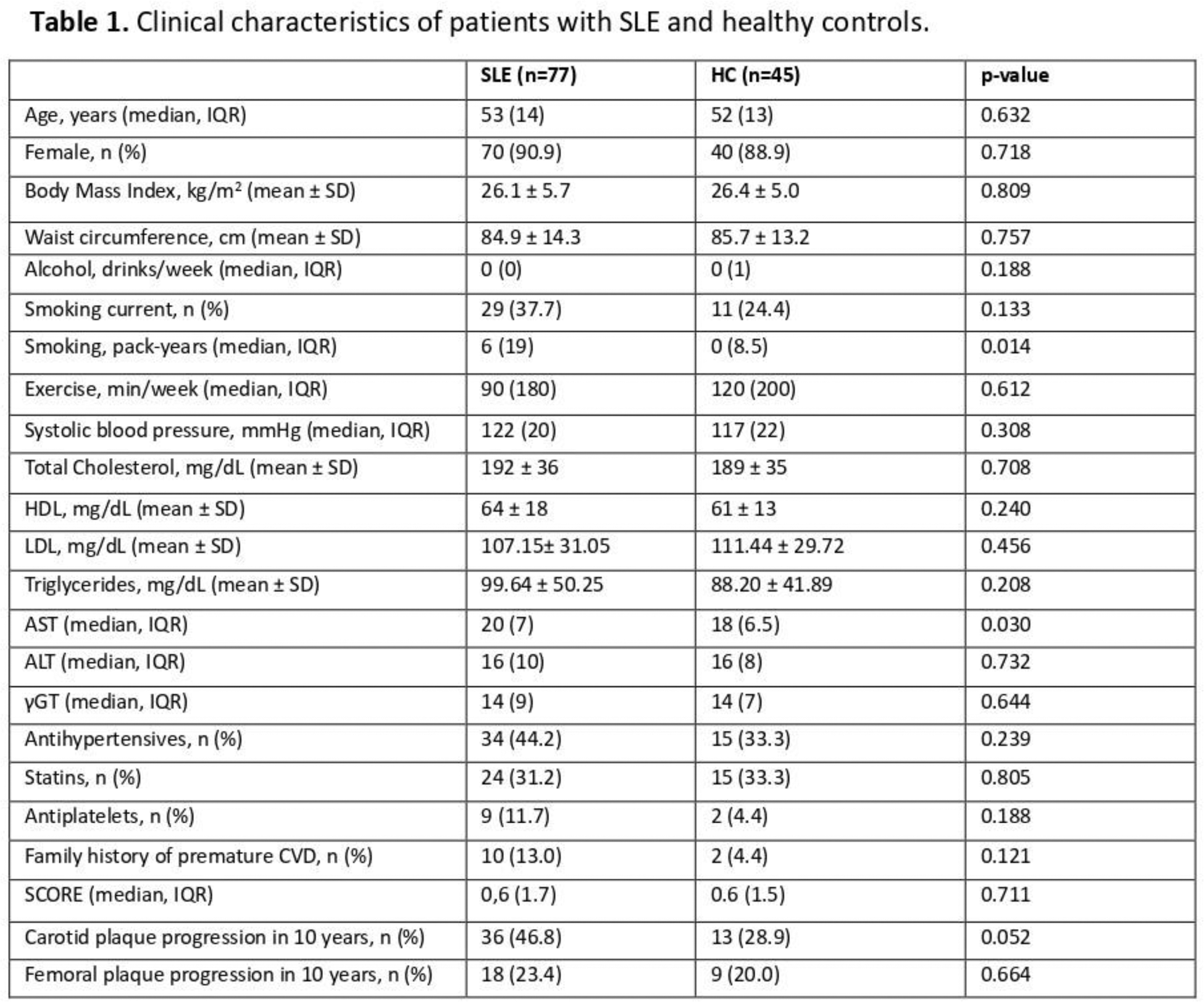

Background: Patients with Systemic Lupus Erythematosus (SLE) have increased risk of cardiovascular disease and subclinical atherosclerosis [1]. Non-alcoholic fatty liver disease (NAFLD) has been recognized as an independent predictor of cardiovascular disease in the general population [2]. However, the prevalence and predictors of NAFLD in SLE is poorly defined.
Objectives: We examined a) the prevalence of NAFLD in patients with SLE compared to healthy control (HC) individuals and b) sustained traditional cardiovascular risk factor (CVRF) goal achievement, disease-related CVRFs, and atherosclerotic plaque progression over the past 10 years as potential predictors of NAFLD in SLE.
Methods: Patients with SLE and age- and sex-matched HCs who had a 10-year carotid and femoral ultrasound follow-up examination in our department were contacted to participate in the study. Exclusion criteria included body weight more than 110 kg, history of HBV or HCV infection, diabetes mellitus and cardiovascular disease at the time of the primary recruitment, malignancy, other hepatic diseases (e.g. cirrhosis, autoimmune hepatitis, Wilson disease) and current pregnancy. Liver transient elastography was performed to assess liver steatosis and fibrosis presence in patients with SLE and HCs. Liver steatosis was graded based on Control Attenuation Parameter (CAP) values, as follows: S0 (absent): 100–238 decibels/meter (dB/m), S1 (mild): 238–260 dB/m, S2 (moderate): 260–290 dB/m, and S3 (severe): > 290dB/m. Liver steatosis presence was defined as grade ≥ S1. Liver stiffness was graded as F0–F1: 2–7 kilopascals (kPa), F2: 7–10 kPa, F3: 10–14 kPa, and F4: > 14 kPa. Liver fibrosis was defined as grade ≥ F2. Using logistic regression models, we assessed potential predictors of NAFLD in patients with SLE, including body mass index (BMI), waist circumference, alcohol consumption, Mediterranean Diet score, physical activity, hypertension, hyperlipidemia, smoking status, and the Systemic Coronary Risk Evaluation (SCORE) prediction score at the time of liver transient elastography. We additionally assessed sustained CVRF target attainment for blood pressure, lipids, smoking, physical activity and body weight (BMI and waist circumference), as defined by the 2016 European Society of Cardiology guidelines, atherosclerotic carotid and femoral plaque progression, the persistent achievement of Lupus Low Disease Activity State (LLDAS), Definition of Remission in SLE (DORIS) clinical remission, and persistent antiphospholipid antibody positivity presence over the past 10-year follow up period. Traditional cardiovascular disease-related medications (antihypertensives, lipid-lowering agents and antiplatelets) and SLE-related medications (cumulative glucocorticoid exposure, consistent hydroxychloroquine use during the 10-year follow-up, immunosuppressives) were also assessed.
Results: We included 77 patients with SLE (91% female, mean age: 53 years, mean disease duration: 19 years, mean BMI: 26kg/m 2 ) and 45 age- and sex-matched HCs (89% female, mean age: 52 years, mean BMI: 26 kg/m 2 ). Characteristics of two groups are shown in Table 1. Liver steatosis presence was comparable between SLE patients and HCs (40,3% versus 44,4% respectively, p=0.651). No liver fibrosis was diagnosed in any of the participants. No association was found between NAFLD and alcohol consumption, Mediterranean diet score, traditional cardiovascular disease- and SLE-related medications, and persistent achievement of LLDAS and DORIS during the 10-year follow-up. In SLE, multivariate analysis showed that sustained attainment of CVRF targets over the past 10 years was inversely associated with NAFLD. Each CVRF that was consistently achieved (including blood pressure, lipids, smoking, physical activity, and body weight) during the 10-year follow up reduced the risk for NAFLD presence by 55% (Odds Ratio [OR]: 0.45, 95% CI: 0.23-0.88, p=0.021). Patients with femoral plaque progression over the past 10 years had a 3.6-fold higher risk for NAFLD presence (OR: 3.62, 95% CI 1.01-12.93, p = 0.021). NAFLD was also independently associated with persistent positivity of IgG anti-beta2 glycoprotein I antibodies (OR: 6.58, 95% CI: 1.33-32.56, p=0.021) during the 10-year follow up.
Conclusion: Atherosclerotic femoral plaque progression and persistent IgG anti-beta2 glycoprotein I antibody positivity were independently associated with NAFLD presence in patients with SLE, while sustained CVRF goal achievement substantially attenuated this risk.
REFERENCES: [1] Papazoglou N, Sfikakis PP, Tektonidou MG. Atherosclerotic plaque progression and incident cardiovascular events in a 10-year prospective study of patients with Systemic Lupus Erythematosus: the impact of persistent cardiovascular risk factor target attainment and sustained DORIS remission. Arthritis Rheumatol. 2024 Dec 25.
[2] Stahl EP, Dhindsa DS, Lee SK, Sandesara PB, Chalasani NP, Sperling LS. Nonalcoholic Fatty Liver Disease and the Heart: JACC State-of-the-Art Review. J Am Coll Cardiol. 2019;73:948-963.

Acknowledgements: NIL.
Disclosure of Interests: None declared.
© The Authors 2025. This abstract is an open access article published in Annals of Rheumatic Diseases under the CC BY-NC-ND license (